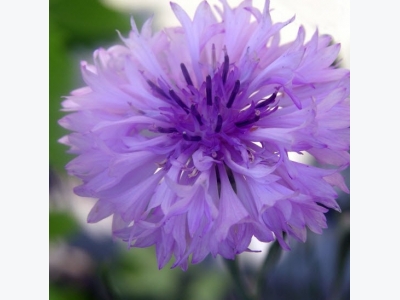How to Grow Cornflower (Bachelor Button)

Cornflower, more commonly known as bachelor button, is a popular, easy to grow annual.
It's a great plant selection for a newbie gardener or the most seasoned growers out there. Its simple beauty has made it a reliable mainstay in gardens since days of old. And it's playful nature keeps modern day gardens exploding with bursts of blue, lavender, pink, and white.
The foliage is covered with fine white hairs, which gives the entire plant a grayish-blue appearance. It's foliage sets bachelor button apart from the ordinary greens of most annual plants, and the flowers are truly delightful.
Bachelor button has the same friendly demeanor of a common wildflower. In spite of this laid back quality though, it is classy enough when cut to afford itself a place in casual yet charming wedding bouquets. To add to its adaptability, bachelor button is a flower that dries well.
How to Grow and Care for Cornflower
Aside from its good looks and charm, what makes the bachelor button an all around favorite is its easy-going nature. While this plant needs a sunny location to bloom the most, you can relax when it comes to soil conditions. It is not choosy. Bachelor button will grow happily in any average soil.
Bachelor button can be started from seed without trouble. Wait until after the last frost to scatter your seeds. Water your seed bed regularly until after the plants have germinated. Store bought transplants are another option for acquiring bachelor buttons. Again, just wait until after the last frost to put your transplants out.
Thin your seedlings back to allow each plant about a foot of space. While they don't mind crowding, they will bloom the most when given some elbow room.
Once your seedlings or transplants have settled in and matured, you can back off on watering some. Just make sure your plants receive about an inch of water a week. Bachelor button will flower from early June through late August. They can flower as early as March in some warmer climates, but count on them for summer flowers.
Expect your bachelor button to spread to about one foot and to grow up to three feet tall. Once they reach about the two and one half foot mark, they might need to be staked to prevent them from falling over. Bamboo stakes and biodegradable twine should do the trick.
Take time to deadhead these flowers to encourage new and continuous blooms. Beyond watering and deadheading, your bachelor button plants shouldn't require anything more from you. Be sure to take time to enjoy their generosity as well as the butterflies and birds they will attract. These flowers also make a great cut flower for bringing inside.
Once you've planted bachelor buttons, you can plan on having them return again next year. They are self seeding which means those deadheads drop seeds that will sprout the following growing season. Make a concerted effort to stay on top of the dried flower heads if you'd rather not see bachelor button in the same location the following year. If you love bachelor button, share the seed heads with your friends.
Cornflower Pests and Problems
Bachelor buttons are generally a very healthy and hardy plant when cared for properly. They can become susceptible to molds, rusts, and mildews if they receive too much water and not enough air circulation and sunshine. They are also prone to wilting in drought conditions. While they don't need a lot of babying, they do need a steady amount of water for optimal health. Also, be on the lookout for aphids and mealybugs.
Cornflower Varieties to Consider
'Blue Boy' adds a brilliant pop of electric blue energy into a garden area. This variety is a standard true blue showstopper.
'Classic Romantic' is a mixed selection that includes flowers varying in shades of pink. The blended effect creates a touch of plush romance and charm.
'White Ball' has a whimsical appearance that is emphasized by the three dimensional petals. This is a heavy bloomer that appears quite heavenly.
Related news
 Care for Fall Flowering Bulbs
Care for Fall Flowering Bulbs These popular garden fillers are some of the most beautiful as well! Fall flowering bulbs are definitely a favorite for keeping the garden in bloom all season
 Caring for Potted Plants
Caring for Potted Plants The perfect place to start to develop your green thumb is right in the comfort of your own home. A potted patio or houseplant is often an inexpensive and simple
 How to Grow Catmint
How to Grow Catmint Catmint (Nepata) is a glorious plant for the mixed bed or perennial garden. It tolerates heat, drought and poor soil and spreads quickly